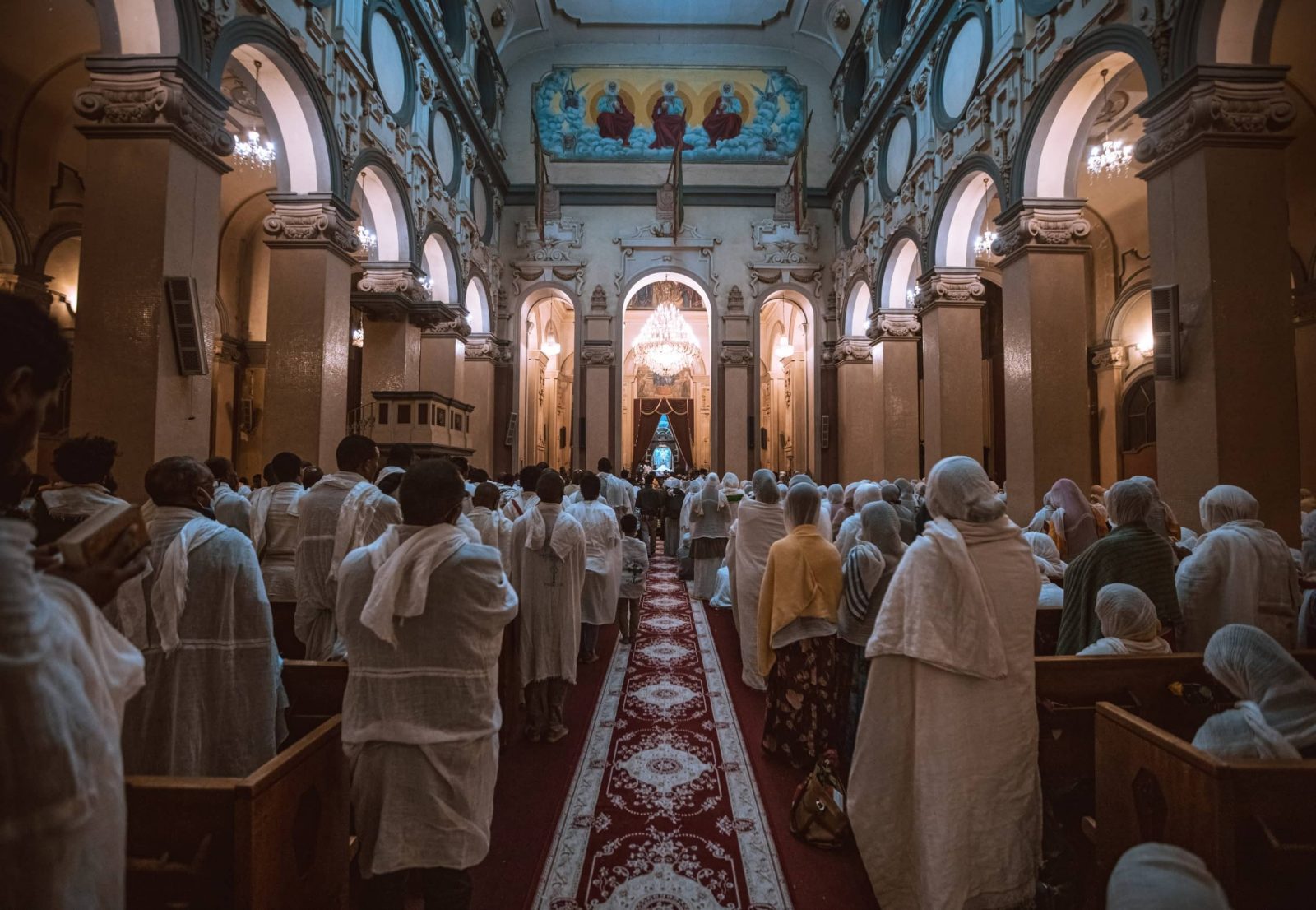Ethiopian Christmas

Abel Merawi is from Addis Ababa. He is an English…
I am writing this article on the present day, 5th month of 2014, Ethiopian Calendar (EC). This may seem odd to a world that just celebrated New Year of 2022. We have celebrated a Christmas at the end of the fourth month after New Year, and Epiphany twelve days afterwards. Just like the rest of the Christianized world, Ethiopians too count the years in anno Domini (AD), the birth of Jesus Christ signifying the date. Yet, we Ethiopians have a different understanding when it comes to the date, month, and year in which Christ was born. In other words, Ethiopians believe Christ to have been born 2,014 years ago on the 29th of the 4th month, while most other countries believe the birth to occur 2,022 years ago on the 25th of the 12th month.
Are Ethiopians lagging by eight years or is the rest of the Christianized world rushing by eight years? Is the Ethiopian celebration of Christmas more spiritual compared to the Western manner? I leave the decision to my readers, but I pray you reserve your judgement until you finish reading. By attaching Ethiopian to Christian holidays, I am not descending down the path of parochialism with a claim of nationality in religion. As you will come to discover hereunder, I am simply implying the distinct features of Christmas in Ethiopia. Let us begin with the calendar and progress to other variations.
Ethiopians continue to use a calendar which resembles both Julian and Gregorian calendars, and yet is different in a major way. We do have a year with 365 days with the 4th year having 366 days, but we have more months. Ethiopia or Abyssinia is among the few nations who possess a fully developed language: spoken and written. I am referring to the Geez language. Of Semitic origin, ‘Geez’ was the language of the ancient Abyssinian/Ethiopian empire. Geez remains functional in Ethiopia, primarily as the language of Ethiopian Orthodox Church. The Ethiopian calendar uses a system developed by the Ethiopian Orthodox Church. Accordingly, Ethiopia is referred as a land with 13 months of sunshine. That is correct, we have 13 months! Here is why. Each month in Ethiopia has 30 days. You may be concerned about the remaining 5 or 6 days. Well, we have gathered the remaining days together and created a 13th month consisting of 5 days, and 6 days every fourth year. We call this month, Puagme. And the reference to ‘sunshine’ is made to show that even the rainy season, unlike winter, allows the sun to shine on the people.

of remembering the baptism of Christ.
This still does not answer the eight-year difference, so let us expound a little on it. An Ethiopian writer named Solomon Abebe Chekol wrote about the issue in 2007, and thanks to his article, I was led to various literatures. Accordingly, we discover that the mistake is attributed to a monk/abbot by the name Dionysius Exiguus, AKA Denis the Little. Dionysius Exiguus arrived in Rome in 496, at the request of Pope St. Gelasius. He was given the task of organizing the pontifical archives. Renowned for his scholarliness, in 525, Dionysius Exiguus was assigned the task of calculating the birth of Christ. This is where he made the unforgivable mistake of using the Roman system that marks the founding of Rome, for calculating the birth of Jesus Christ. The mistake ended up adding extra 8-year to the birth of Christ. Despite this error, Dionysius influenced the modern world as the inventor of Anno Domini (AD). Ethiopia had already adopted Christianity by this time, and strictly observed the calendar, which had not been tampered with and tweaked by Denis the Little. In the end, the rest of the world fails to correct the error while accepting it. In the end, we are all living in 2014, even if most assume it’s 2022.
The Bible makes no reference to an exact date, but there are references to the season. We can find the Bible reference in statements from Luke 2:10-21. While the Bible does not mention the birth date of Jesus Christ, the reference made to shepherds and sheep spending the night out when first hearing of Christ’s birth, indicates spring rather than winter. If this is the truth, then why do Christians in European and other nations celebrate it during winter?
Saturnalia and Christmas
To answer this question, we will momentarily shift our focus to Christmas in European nations, and come back to Ethiopia afterwards. Here, I would like to point out that the reference to Europe applies to the rest of the world that was under the influence of Europe. The influence finds its origins in colonization, slavery and Westernization in the name of globalization. Most contend that Westernized Christmas resembles, in time and manner of celebration, the Roman pagan holiday known as Saturnalia.
The similarities between Saturnalia and Christmas can be linked to the conquests of the Roman Empire in most of Europe, which extended from the second century BC to the fourth century AD. During this long conquest, the Romans suppressed other rituals and imposed their own, including Saturnalia. It is assumed that Christian churches in the West moved the date to December in 4th c. AD to disguise and celebrate Christmas while Romans celebrated Saturnalia. It is worth remembering here that Europeans did the very same thing to Africans and to the rest of the colonized world, if not worse. As we all know, Europeans failed to learn from the cruelty of their captivity for they imposed their religions, including Christmas celebration, when they become colonizers and slavers.
Saturnalia is a celebration in ancient Rome. It is a pagan festival held in honor of Saturn – the agricultural god. It was said to be celebrated for an entire week starting in midwinter, in the sowing season. It extends from December 17-25, which coincides with Christmas. The Temple of Saturn, constructed in 4th century A.D in Rome, served as the center of Saturnalia festivities. The celebration had many rituals related to gift offerings and sacrifices to Saturn so that this god would endow the people with abundance during harvest.
Saturnalia continues to influence modern Christmas celebration in noticeable manners. To start with all forms of work cease during Saturnalia, even slaves were allowed to participate in the celebration. In token of humility, it was even said that the masters served their slaves. The people busy themselves with home decorations, using green foliage such as wreaths. This was done in praise of the agricultural god, Saturn, who is to bring green back to earth after winter. Moreover, the Romans display their merrymaking by singing, dancing, gambling, socializing, feasting, and gift giving. The greenery that decorates homes, and the common gift of wax candle known as cerei, symbolize the end of solstice and the return of the sun or light. I think you have already identified the striking similarities between Saturnalia and Christmas, but I’ll still indicate them.
During Christmas, it is common to stop work and busy oneself with preparations, just as it was done to celebrate Saturnalia. The home decoration is truly a reminder of Saturnalia. Christmas trees have become integral to Christmas. We have already seen how homes are decorated during Saturnalia with greenery, and it is the same with Christmas trees. But as Jesus was born in Spring, and He promises to bring the world salvation rather than harvest, the trees lack a religious component. Gift giving has also been part of Saturnalia, just as it is with modern Christmas celebration. These and other similarities point to the cultural and religious hegemony Romans had over most of Europe, and in turn, it shows the hegemony of Europeans over most nations in the world through colonization. This explains the uniqueness of Ethiopian Christmas, while also symbolizing the true meaning of Ethiopian historical independence.
History of Christianity in Ethiopia
Ethiopians converted to Christianity in the 340 AD, when Ethiopia flourished in its ancient Axumite kingdom. While all agree with the date, the kings responsible for embracing Christianity differ. Some scholars suggest that it was during the reign of Kings Abreha and Asbeha, and others contend that it was in the reign of King Ezana. Either way, Christianity failed to be a weapon of colonization in Ethiopia, as was the case in most African countries. When the missionaries came, Ethiopians were already Christians. They could even teach a thing or two to the false preachers of the Western World, who blasphemed by using Christianity as an extension of colonization.
The myth of white supremacy was a laughable concept to Ethiopians for two reasons. First, Ethiopians were already Christians, while Europeans were fighting pagan wars and were under the hegemony of the Roman Empire. Second, Ethiopians were ruled by Kings and Queens who claimed to trace their lineages back to King Solomon and Queen of Sheba. The myth, mixed with history, portrays Queen of Sheba (Nigist Saba) as an Ethiopian queen, who begot a child from King Solomon of Israel. It is said that Queen Saba and King Solomon has a child named Menelik, who ruled Ethiopia. Every Ethiopian emperor claimed to possess a bloodline with Menelik. Ethiopians were ruled by Kings rather than Chieftains and barbaric tribe leaders of Europe – be it Celtics, Vikings or Nordics. It is worth departing from this point by emphasizing the fact that it was Emperor Menelik II, who defeated the Italian colonizers in the battle of Adwa, and Emperor Haile Selassie, whose name echoes the spirit of the Trinity, who defeated the fascists. Christianity in Ethiopia, through the Orthodox Christian Church, gave birth to Kings who championed freedom for all. Let us now proceed to the Christmas celebration, according to the teachings of the Orthodox Christian Church.
Ethiopian Christmas
Genna is the name of Christmas in Ethiopia. It is a holy and spiritual celebration. I hope you will not feel disappointment when I say: there will be no Santa Clause, no colorfully wrapped secret gifts, and no Christmas trees decorated with lights. Do not worry, for a grander celebration awaits you. In Ethiopia, you will celebrate Christmas enveloped in the eternal joy only Jesus endows on His flocks. You will await Christmas with spiritual eagerness – this day marks world salvation through the birth of Jesus Christ.
The birth of Christ is monumental to Christians, and for the Ethiopian Orthodox Church, it is awaited with fasting. Before Christmas, Christians participate in 43-days of fasting named Tsome Nebiyat (Fast of the Prophets). The fasting is a religious way of praying for deliverance, and of cleansing oneself for the birth of Christ. The fast ends on Gahad or Christmas Eve with Christians partaking in an overnight Mass. Lo and behold! Christ is born on January 7 or on 29th of Tahsas, the 4th month of Ethiopian calendar.
Christmas in Ethiopia is both spiritual and communal. It is spiritual since families go to church in the morning to sing hymns in praise of the Lord who brought salvation through His son, Jesus Christ. It is communal because relatives and neighbors return from church and feasting together. Dining too has a fascinating aspect in Ethiopian tradition. During holidays it is customary to slaughter sheep and chicken at home and invite neighbors and relatives. There is also a communal tradition in which neighbors collect money, buy cattle, and share the meat. Then, various dishes are prepared and served on a big plate, with everyone eating together. Then, traditionally, young people gather and play a game similar to hockey known as Yegena Chewata, and Yeferes Gugs, which is played on horseback with combatants throwing ceremonial spears in token of ancient hunting traditions. The manner of fasting, feasting and playing genuinely embody the spirit of Ubuntu, because Christmas in Ethiopia is a day of togetherness in body and spirit.
In the end, Christmas in Ethiopia is similar to Christmas everywhere in the world – a spiritual celebration. I only wish to show you that there is a more spiritual way of celebrating the birth of Christ. Christmas can do without the Roman pagan tradition of Saturnalia, and also without consumerism. The communal life of Africa is embodied in Ethiopia, and this is fostered by the spirituality Christmas demands. Currently, Ethiopians have adopted some aspects from the popular ways of Christmas celebration across the world. I think the world can also adopt some aspects from the Ethiopian Christmas.
Main Points About Christmas in Ethiopia
Christmas in Ethiopia is not typically held on the 25th of December, but it is held on the 7th of January.
Before Christmas, there is a 43 day fast (fast of the Prophets). During this fast, Ethiopians stick to traditional vegan meals.
For Christmas, people in rural areas wear white toga or shawl with brightly colored stripes at the tip. While the people in the cities typically wear western attire.
On Christmas eve, many Ethiopians are gaily dressed for the evening mass.
Typically, many Ethiopians stick to their traditional Christmas meals. They include meat stew, eggs, and vegetables.
What's Your Reaction?
Abel Merawi is from Addis Ababa. He is an English literature teacher, freelance writer/reporter for Ezega.com and an Amharic-English translator and editor. He also writes for www.msingiafrikamagazine.com. You can reach him via: abelmerawi4@gmail.com


















